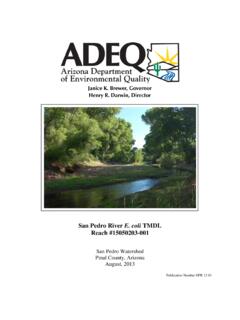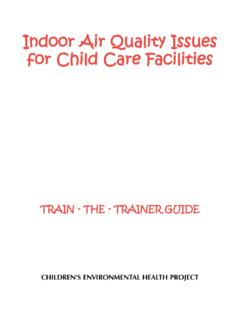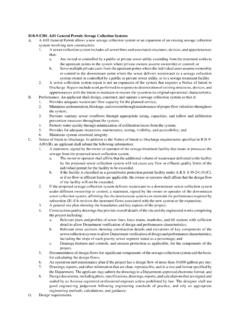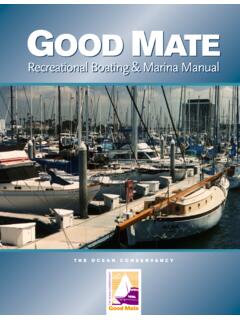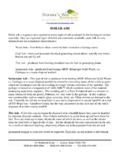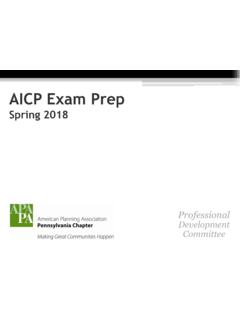Transcription of School Operations and Maintenance: Best Practices for ...
1 School Operationsand Maintenance: best Practices for ControllingEnergy CostsA Guidebook for K-12 SchoolSystem Business Officers andFacilities ManagersAugust 2004 Prepared by: Princeton Energy Resources International1700 Rockville PikeSuite 550 Rockville, MD 20852 HPowell Energy Associates20 Acton RoadWestford, MA 01886 Alliance to Save Energy1200 18th Street, NWSuite 900 Washington, DC 20036 ContentsACKNOWLEDGMENTS .. iEXECUTIVE SUMMARY .. iiiCHAPTER 1. INTRODUCTION .. Target Audience .. Organization of Document .. Input from Reviewers .. 3 CHAPTER 2. ENERGY COSTS, O&M AND BUDGET PRIORITIES .. Energy Costs are a Major Component of the School Budget .. Energy Use in School Facilities Relates to Educational Objectives .. Good O&M Practices Increase Energy Efficiency .. What is Operations and maintenance (O&M)?
2 The Need for Energy Management O&M Programs .. The Approach to Energy Savings Opportunities .. 11 CHAPTER 3. INVESTIGATING O&M FOR YOUR DISTRICT: UNDERSTANDING PROGRAM ISSUESAND PITFALLS .. Overview/Summary: .. Overview of The Five-Phase Development Process .. Initial Investigation Phase .. Educate Yourself O&M Program Identifying Outside Assistance .. Understanding the Broad Technical Issues .. Initial Investigation Phase: Challenges to Starting and Operating a Program .. Initial Assessment of District Opportunities .. Gathering Information from Staff .. Informal Building Walkthrough Survey .. Summary of Findings .. 24 CHAPTER 4. NUTS AND BOLTS: PLANNING AND IMPLEMENTING AN O&M PROGRAM THAT FITS Overview .. Senior Staff: Building an Initial Constituency.
3 Testing the Waters.. Nuts and Bolts: Planning a District-Wide O&M Task Force: Collecting Additional Data .. Task Force: Investigating Program Options .. Task Force: Developing a Program Recommendation .. Task Force: Planning a Detailed Program .. Defining a District-Wide Energy Policy .. Developing a Program Staff and Recognizing and Motivating Staff Members .. At Last: Implementing the Program .. Critical Factor #1: Program Visibility and Progress Reporting .. Critical Factor #2: Energy Savings .. Critical Factor #3: Distribution of Critical Factor #4: Course Changes and Program Flexibility .. Critical Factor #5: External Support .. Critical Factor #6: Detailed Procedures Manual .. Implementing the Program: A Final Word .. 48 CHAPTER 5. TECHNICAL OPPORTUNITIES FOR ENERGY EFFICIENCY IMPROVEMENT.
4 Overview .. Energy End-Use Profile .. Examples of O&M Strategies .. Lighting .. Manual Light Switch (Turn Them Off) .. Keep Them Clean .. Window Blinds and Window Film .. Exit Signs .. Delamping .. Relamping .. Automatic Lighting Controls .. Lighting Retrofits .. Computers and Office Equipment .. Personal computers .. Printers .. Building Envelope .. Heating, Ventilating, and Air Conditioning (HVAC) .. Heating .. Air Conditioning .. Water Heating .. Kitchen equipment and Operations .. Swimming pools .. Vending machines .. Other Special Equipment (Laminators, Kilns, and Shop Machines) .. Portable (Relocatable) Classrooms .. 68 CHAPTER 6 CASE STUDIES .. Case Study Overview .. Organizational Case Studies .. Belding Area Schools Belding, Kent School District Kent, Washington.
5 Marion County Public Schools Ocala, Florida .. Montgomery County Public Schools Rockville, Maryland .. Rochester City, New York School District Case Study .. Tracy, California School District .. 91 CHAPTER 7. Operations AND maintenance REFERENCES AND RESOURCES .. Operations and maintenance Guides and Manuals .. Additional Operations and maintenance Manuals and Technical Guides .. Energy Management Guides .. Technology Specific Measuring Savings and Benchmarking .. Training Additional Resources with Internet Addresses .. 101 APPENDIX A - IDENTIFYING OUTSIDE A-1A-1. O&M Program Assistance from Federal, State, and Government Agencies .. A-1A-2. O&M Program Assistance from Consultants .. A-1A-3. O&M Program Assistance from Local and Non-Profit Sources .. A-2A-4.
6 O&M Program Assistance from Energy Service A-3 APPENDIX B. School DISTRICT O&M PROGRAM MANAGER QUALIFICATIONS AND RESPONSIBILITIES .. B-1 APPENDIX C. EXAMPLES OF School ENERGY POLICY STATEMENT AND IMPLEMENTATION PLAN .. C-1C-1. Sample Energy Policy Statement, Texas School Performance C-1C-2. Energy Policy and Implementation Plan From a Large School District in Suburban Maryland .. C-2C-3. Detailed Energy Policy and Implementation Plan From a Medium-Sized School District in Massachusetts .. C-3iAcknowledgmentsACKNOWLEDGMENTSThis best Practices Guidebook was funded by a grant from the Departmentof Energy, Office of Energy Efficiency and Renewable Energy. Specifically, theauthors would like to thank Margo Appel, National Federal Coordinator, EnergySmart Schools, for supporting the effort to develop, produce, and distribute authors would also like to thank the Association of School Business Officials(ASBO), the Association of Higher Education Facilities Officers (APPA), and theNational School Plant Managers Association (NSPMA) for their contributions tothe development and distribution of this , the authors of the Guidebook would like to extend their gratitude to theoperations, maintenance , education, and other professionals who volunteered theirtime to review early drafts of the document.
7 Reviewers, through their real worldexperiences, provided constructive and substantial contributions that considerablyimproved this document. The following is a list of individuals who shared theirexperiences and expertise as reviewers:Tom Beck, Director of Operations and maintenance , Neenah Joint SchoolDistrict, WisconsinJoe Bolton, Executive Director, Facilities Management, Jefferson County PublicSchools, ColoradoJohn P. Bowers, Facility Management Consultant for K-12 and Higher Educa-tion; Former Director of Operations for Grand Valley State University, KentwoodPublic Schools and Belding Area Schools, MichiganTom Coughlin, School Initiative Manager, National Grid USA, MassachusettsDoug Lewis, Assistant Superintendent for Business and Finance, Ralston PublicSchools, NebraskaDean Lueck, Resource Conservation Manager (RCM)
8 Consultant, WashingtonFrank Norwood, Former Director of maintenance and Operations for KatyIndependent School District, Member of the ASBOI/ NFES Task Force for the"Planning Guide for Maintaining School Facilities", TexasDavid Petersen, Assistant Director, Administrative and Operations Services,Fairfax County Public Schools, VirginiaLee Provost, Founder and President, , North CarolinaAndrea Ranger, School Building Assistance Project, Department of Education,MassachusettsChristopher Russell, Alliance to Save Energy, Washington Rutherford, Project Manager, School Initiative, Northeast Energy EfficiencyPartnershipsCharlie Schneider, School and Government Sector Manager, Focus on Energy,WisconsinLarry Schoff, Department of Energy, Rebuild America, Oak Ridge NationalLaboratory, EnergySmart Schools, VirginiaJim Shearouse, maintenance Director/Clerk of Works, East Stroudsburg SchoolDistrict, PennsylvaniaGary Stanley, Director of Operation, Aptakisic School District, IllinoisRobert Van Der Like, Energy Management Specialist, Marion County PublicSchools, FloridaRoger Young, Assistant Superintendent of the Manchester Essex RegionalSchool District, MassachusettsiiiExecutive SummaryOverviewOperations and maintenance (O&M) offers not only strategies for maintainingfacilities, but also opportunities for reducing energy costs and increasing energyefficiency at existing schools, regardless of age.
9 This Guidebook provides de-tailed and practical guidance on how K-12 School districts can plan and imple-ment enhancements to their current O&M programs that can successfully main-tain their facilities while also reducing energy costs up to 20%. Most of theenergy management strategies detailed in the Guidebook entail limited capitalcosts and produce rapid paybacks, in most cases, of less than two Guidebook is intended for School district facilities management staff andschool business staff (including Superintendents and School Board Members)who have the authority to implement such a program. School -based maintenanceand custodial managers may also use this resource to help them identify andunderstand program details and to see the contribution they can make to the newO&M Guidebook is designed to meet the specific needs of School district staff forintegrating energy efficiency into School building operation and maintenance byproviding not only technical information, but also organizational information onbarriers, challenges, and the necessary steps required to develop this type ofenergy management program within the School district organizational structure.
10 Inaddition, it contains case studies that are essential to providing experience-basedobservations and "real life" approaches to which School district staff can Guidebook identifies common strategies that have proven successful in awide variety of American School districts, providing an overview of the broaderissues raised in published O&M "literature," as well as in the real-life School -based professional experiences of its authors and contributors. It offers a clearunderstanding of the various staffing, program design, and other options availableto School administrators as they plan and implement the details of their district'sO&M effort. With a more complete knowledge of all the options and alternatives, School administrators will be better able to design and implement an energymanagement effort that is appropriate to, and successful in, their own Conclusions and Recommendations1) High energy costs are not "fixed" and can be reduced by 5% to 20% byeffectively managing, maintaining, and operating School physical plants,regardless of School ) School organizations can readily utilize techniques to systematically assessO&M Practices in their physical plant as well as the magnitude of potentialenergy-saving opportunities resulting from changed O&M ) Substantial energy savings can be achieved from improved O&M practiceswithout significant capital )
